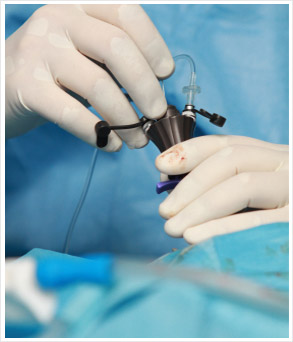Have You Had Abdominal Surgery?
Laparoscopic Ventral Hernia Repair
 Anyone who has had abdominal surgery is at risk for developing hernias—a weakness or tear in the strong fascial tissue that holds the abdomen together—through the surgical site. You may have an incision or ventral hernia if you have noticed a bulge or feel pain around your scar when lifting heavy objects or coughing. If a hernia develops there is danger of bowel or other intra-abdominal contents getting "stuck" in the fascial defect. This can lead to a bowel obstruction possibly requiring resection of part of the bowel and the potential to become quite sick. For this reason patients should be evaluated by their doctor and hernias repaired in the operating room.
Anyone who has had abdominal surgery is at risk for developing hernias—a weakness or tear in the strong fascial tissue that holds the abdomen together—through the surgical site. You may have an incision or ventral hernia if you have noticed a bulge or feel pain around your scar when lifting heavy objects or coughing. If a hernia develops there is danger of bowel or other intra-abdominal contents getting "stuck" in the fascial defect. This can lead to a bowel obstruction possibly requiring resection of part of the bowel and the potential to become quite sick. For this reason patients should be evaluated by their doctor and hernias repaired in the operating room.
There is a new surgical approach to fixing relentless incisional hernias—laparoscopy. Laparoscopy is videoscopic surgery involving placing a video camera and surgical instruments through small incisions into the abdomen. Although laparoscopy is not really "new," it is now being readily utilized in repairing hernias in the abdominal wall, especially large ones recurring through incisional scars.
 Ventral hernias are traditionally repaired with an "open" technique. That is, the old incision is opened, the hernia is identified, and the defect is closed using strong sutures if it is small or synthetic material like Gortex or mesh to bridge the gap in larger defects. The skin is then closed over this. Sometimes a drain is left to evacuate fluid that accumulates under the skin. Recovery varies with the extent of surgery, but for larger hernias requiring mesh to heal it is usually a couple days in the hospital, six weeks of light activity. The laparoscopic approach really makes a difference in these larger, often recurrent hernias. Laparoscopy involves insufflating the abdomen with gas and placing the video camera and instruments into the abdomen approaching the hernia from the inside, away from the old scar. The hernia is then repaired by placing a Gortex patch inside the abdomen and suturing it to create a new abdominal wall. Patients tend to tolerate the procedure better than the "open" approach and are left with only a few small (one to two cm) incisions to heal rather than the larger wound. Laparoscopic ventral hernia repair can be employed in most cases where the open approach is used. It is especially rewarding in larger hernia defects requiring synthetic material.
Ventral hernias are traditionally repaired with an "open" technique. That is, the old incision is opened, the hernia is identified, and the defect is closed using strong sutures if it is small or synthetic material like Gortex or mesh to bridge the gap in larger defects. The skin is then closed over this. Sometimes a drain is left to evacuate fluid that accumulates under the skin. Recovery varies with the extent of surgery, but for larger hernias requiring mesh to heal it is usually a couple days in the hospital, six weeks of light activity. The laparoscopic approach really makes a difference in these larger, often recurrent hernias. Laparoscopy involves insufflating the abdomen with gas and placing the video camera and instruments into the abdomen approaching the hernia from the inside, away from the old scar. The hernia is then repaired by placing a Gortex patch inside the abdomen and suturing it to create a new abdominal wall. Patients tend to tolerate the procedure better than the "open" approach and are left with only a few small (one to two cm) incisions to heal rather than the larger wound. Laparoscopic ventral hernia repair can be employed in most cases where the open approach is used. It is especially rewarding in larger hernia defects requiring synthetic material.
Please call 410-571-9499 for more information. We will be happy to address your questions and concerns.






